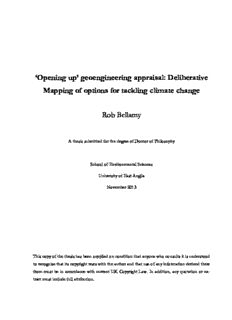
geoengineering appraisal: Deliberative Mapping of options for tackling climate change Rob Bellamy PDF
Preview geoengineering appraisal: Deliberative Mapping of options for tackling climate change Rob Bellamy
‘Opening up’ geoengineering appraisal: Deliberative Mapping of options for tackling climate change Rob Bellamy A thesissubmittedforthe degree ofDoctorofPhilosophy School ofEnvironmentalSciences University ofEastAnglia November2013 This copy of the thesis has been supplied on condition that anyone who consults it is understood to recognise that its copyright rests with the author and that use of any information derived there from must be in accordance with current UK Copyright Law. In addition, any quotation or ex- tractmustinclude full attribution. 2 Abstract Deliberate large-scale interventions in the Earth’s climate system, known collectively as climate ‘geoengineering’, have been proposed in order to moderate anthropogenic climate change. A host of normative rationales for geoengineering has led to a growing number of appraisals to evaluate the different proposals and provide decision support. This thesis critically reviews current ap- praisals of geoengineering before developing and executing its own appraisal methodology in re- sponse to their limitations. These limitations concern: (1) the appraisal of geoengineering pro- posals in ‘contextual isolation’ of alternative options for tackling climate change; (2) inadequate methodological responses to the ‘post-normal’ scientific context in which climate change and ge- oengineering resides; and (3) a premature ‘closing down’ upon particular geoengineering pro- posals, principally stratospheric aerosol injection, through the exertion of power via framings. This thesis exhibits the findings of an ‘upstream’ participatory appraisal of geoengineering called Deliberative Mapping; an innovative analytic-deliberative methodology designed to ‘open up’ ap- praisal inputs and outputs to a broader diversity of framings, knowledges and future pathways. A diversity of international experts and stakeholders from across academia, civil society, industry and government, and of sociodemographically representative citizens from Norfolk (UK), were engaged using a combination of analytic Multi-Criteria Mapping specialist interviews and deliber- ative citizens’ panels, as well as a joint specialists-citizens workshop. The results present a radical- ly different view to other appraisals of geoengineering, where: (1) geoengineering proposals are most often outperformed by mitigation options, with stratospheric aerosol injection ranking par- ticularly poorly; (2) a greater diversity of perspectives and assessment criteria spanning the natu- ral, applied and social sciences reveals considerable uncertainties in all areas of research and deci- sion making; and (3) four propositions for governance emerge that advance sociotechnical fore- sight, technology control and public consent, the anticipation and alleviation of impacts, a demonstration ofrobustness, andultimately, the responsible innovation ofgeoengineering. 3 4 Tomyparents, Hilaryand Michael, for theireternal love, supportandencouragement 5 6 Contents Abstract 3 Listof Figures 15 Listof Tables 17 Acknowledgements 19 Chapter 1: Introduction 23 1.1 A history ofclimate control 24 1.2 Defining ‘geoengineering’ 26 1.3 Thesisrationale andcontribution 28 1.4 Researchthemesandquestions 31 1.5 Thesisstructure andcontent 32 Chapter 2: Theoretical Perspectives on Social Appraisal 36 2.1 The ‘participatory turn’ in science policy 37 2.1.1 Science in the risk society 37 2.1.2 Uncertainty andparticipation 40 2.1.3 Fromdeficittodialogue 43 2.1.4 Moving participation‘upstream’ 45 2.2 ‘Closing down’and‘opening up’ social appraisal 47 2.2.1 Powerandframing in‘social’ appraisal 47 7 2.2.2 Diversity andreflexivity 50 2.3 Socialappraisal aspartofresponsible innovation 53 Conclusions 57 Chapter 3: A Review of Climate Geoengineering Appraisals 59 3.1 Review methodandresults 59 3.2 Findingsofgeoengineering appraisals 63 3.2.1 Expert-analyticappraisalsofgeoengineering 63 3.2.2 Geoengineering governance andethics 66 3.2.3 Participatory anddeliberative appraisalsofgeoengineering 69 3.2.4 Media discourse analysesofgeoengineering 74 3.3 Framing geoengineering appraisal 75 3.3.1 Problemdefinition andcontextual situation 75 3.3.2 Appraisal methodsandcriteria selection 78 3.3.3 Reflexivityandoutputrecommendations 84 Conclusions 86 Chapter 4: Methodology 88 4.1 Deliberative Mapping 88 4.1.1 Methodselection 89 4.1.2 Methodoverview 89 4.1.3 Pilots 91 4.1.4 Framing 92 4.2 The specialiststrand 94 4.2.1 Specialistscoping andrecruitment 95 8 4.2.2 Multi-Criteria Mapping interviews 96 4.3 The citizenstrand 96 4.3.1 Citizenscoping andrecruitment 97 4.3.2 Firstcitizens’ panel andresource website 98 4.3.3 Jointworkshopandsecondcitizens’ panel 99 4.4 Analytical methods 100 4.4.1 Quantitativeanalytical methods 100 4.4.2 Qualitative analyticalmethods 101 Chapter 5: Specialist Strand Results and Discussion 102 5.1 Optionsandcriteria 102 5.1.1 Additional options 102 5.1.2 Criteria groups 103 5.2 Option scoring 105 5.2.1 Efficacy 105 5.2.1.1 Theefficacyof differentgeoengineeringproposals 105 5.2.1.2 Theefficacyof differentmitigation options 107 5.2.1.3 Theefficacyof businessasusual 108 5.2.2 Environment 108 5.2.2.1 Theenvironmental impactsof differentgeoengineeringproposals 108 5.2.2.2 Theenvironmental impactsof differentmitigation options 110 5.2.2.3 Theenvironmental impactsof businessasusual 112 5.2.3 Feasibility 112 5.2.3.1 Thefeasibilityof differentgeoengineeringproposals 112 9 5.2.3.2 Thefeasibilityof differentmitigation options 114 5.2.3.3 Thefeasibilityof businessasusual 115 5.2.4 Economics 115 5.2.4.1 Theeconomicsof differentgeoengineeringproposals 115 5.2.4.2 Theeconomicsof differentmitigation options 117 5.2.4.3 Theeconomicsof businessasusual 118 5.2.5 Politics 118 5.2.5.1 Thepoliticsof differentgeoengineeringproposals 119 5.2.5.2 Thepoliticsof differentmitigation options 120 5.2.5.3 Thepoliticsof businessasusual 121 5.2.6 Society 121 5.2.6.1 Thesocial implicationsof differentgeoengineeringproposals 121 5.2.6.2 Thesocial implicationsof differentmitigation options 123 5.2.6.3 Thesocial implicationsof businessasusual 124 5.2.7 Ethics 124 5.2.7.1 Theethicsof differentgeoengineeringproposals 124 5.2.7.2 Theethicsof differentmitigation options 125 5.2.7.3 Theethicsof businessasusual 126 5.2.8 Co-benefits 126 5.2.8.1 Theco-benefitsof differentgeoengineeringproposals 127 5.2.8.2 Theco-benefitsof differentmitigation options 127 5.2.8.3 Theco-benefitsof businessasusual 127 5.3 Criteria weighting andoption ranking 128 10
Description: